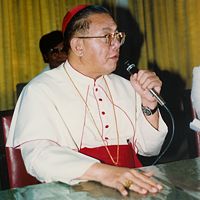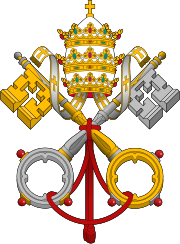Jaime Sin
| His Eminence Jaime Lachica Cardinal Sin |
|
| Cardinal Archbishop of Manila | |
 |
|
| See | Manila |
|---|---|
| Enthroned | March 19, 1974 |
| Ended | September 15, 2003 |
| Predecessor | Rufino Jiao Cardinal Santos |
| Successor | Gaudencio Cardinal Rosales |
| Created Cardinal | May 24, 1976 |
| Other | Archbishop of Jaro |
| Born | August 31, 1928 New Washington, Aklan, Philippines |
| Died | June 21, 2005 (aged 76) |
| Buried | Crypt at the Manila Cathedral |
Jaime Cardinal Sin, also Jaime Lachica Cardinal Sin (August 31, 1928–June 21, 2005) (Chinese name: 辛海梅; 辛海棉 Xīn Hǎiméi; Xīn Hǎimián), was an archbishop of the Roman Catholic Church in the Philippines. He led the Archdiocese of Manila as its archbishop and was later made cardinal by Pope Paul VI. As Archbishop of Manila, he was widely considered Primate of the Philippines, though no formal dignity has ever been attached to the archdiocese. He retired as the Archbishop of Manila on September 15, 2003, having reached the age of retirement for prelates under Canon Law, and was succeeded by Gaudencio Rosales. He was only the third native Filipino Archbishop of Manila, following centuries of Spanish, American and Irish episcopacy. He died at the age of 76 on June 21, 2005.
His name should not be confused with "cardinal sin", which is synonymous for the seven deadly sins, and it has also been the source of many jokes in the Philippines revolving around him such as "The greatest sin of all...Cardinal Sin" or "Welcome to the House of Sin" referring to his Church. (it was also an item in "Ripley's Believe It or Not"). Sin is actually a Spanish surname which means "without".
Contents |
Priesthood and episcopacy
Sin was born in New Washington, Aklan, Philippines to Juan Sin (of Chinese ancestry) and Máxima Lachica (of Aklanon ancestry). He was the seventh of sixteen children. He is the brother of Dr. Ramón L. Sin. He eventually left his childhood home and his family to study in seminary. He entered St. Vincent Ferrer Seminary, was ordained to the presbyterium and became a priest of the Archdiocese of Jaro on April 3, 1954. He was appointed its auxiliary bishop on February 10, 1967. Following his appointment, he was ordained as bishop of the titular see of Obba on March 18 of that year. On March 15, 1972, Sin was appointed Coadjutor Archbishop of Jaro, taking on administrative roles in the archdiocese, while holding the titular see of Massa Lubrense. On October 8, 1972, Sin was appointed Archbishop of Jaro, taking full control of the archdiocese.
Sin's service as Archbishop of Jaro ended with his appointment on January 21, 1974 to the larger archdiocese seated in the nation's capital of Manila. Sin was officially installed as Archbishop of Manila at the Manila Cathedral on March 19, 1974. On May 24 of 1976, Pope Paul VI summoned Sin to the Holy See to be join the College of Cardinals, being created Cardinal Priest of the titular church of Santa Maria ai Monti. He remained the youngest member of the College until 1983.
People Power movement
| Styles of Jaime Cardinal Sin |
|
| Reference style | His Eminence |
| Spoken style | Your Eminence |
| Informal style | Cardinal |
| See | Manila (Emeritus) |
Events in the Philippines under President Ferdinand Marcos forced Sin, the spiritual leader of all Filipino Catholics, to become involved in the politics of the region. He became witness to corruption, fraud and even murder at the hands of the regime — events that pushed Filipinos to the brink of civil unrest and even war. Sin appealed to Filipinos of all religions to follow the teachings of Jesus in the Gospels and use peaceful means to change the political situation in the Philippines.

At the same time, President Marcos and First Lady Imelda Marcos, let Sin to side with the regime. President Marcos ordered his generals to deploy against the marchers, however, tanks and troops were stopped in the streets with people on their knees praying the Rosary and singing English language translations of sacred hymns. Some soldiers decided to join the marchers.
In what later became known as the People Power Revolution, President Marcos, his family and close advisors were forced to flee the Philippines — taking up residence in Honolulu, Hawaii upon the invitation of President of the United States Ronald Reagan. Cardinal Sin, along with Presidents Corazon Aquino and Fidel Ramos, became known to Filipinos as the architects of the People Power Movement.
In 1994, he tried to stop the registration of the Iglesia ni Cristo in Rome but he was unsuccessful with his plan.
Sin decided to intervene again, in 2001, to become the spiritual leader of another People Power Movement. Filipinos alleged that President Joseph Estrada was guilty of widespread corruption and graft. Marches in the streets, with the support of Sin, succeeded in toppling President Estrada from power and elevating Gloria Macapagal Arroyo as his successor.
Two and a half years after Sin's death, it was reported that at the height of EDSA II, Sin received a directive from the Vatican ordering him and the Philippine clergy to adopt a non-partisan stance towards the political crisis.[1] Sin, who by then had committed support for the EDSA II revolt, was said to have threatened to resign as Archbishop if compelled to withdraw his support.[1] The standoff was reportedly resolved with the mediation of then-Supreme Court Associate Justice Artemio Panganiban[2], a member of the Pontifical Council for the Laity which was an advisory body to the Pope.[1] As a result, the Vatican did not insist upon its earlier demand. While the reports had been attributed to persons with reputed first-hand knowledge of the events,[1] there has been no official confirmation of these accounts, whether from the Vatican or from the Archdiocese of Manila.
Sin was decorated three times by the Philippine government. The first was by President Corazon C. Aquino, who conferred him with the Philippine Legion of Honor, rank of Chief Commander; the second, by President Joseph Estrada, who conferred on him the Order of Sikatuna, rank of Rajah; the final time was shortly after his retirement, when President Gloria Macapagal-Arroyo conferred on him the Order of Lakandula, rank of Bayani (Grand Cross).
His name prompted many jokes – a cardinal sin is one of the seven deadly sins – and Sin himself made light of it. He often referred to his residence as "the house of Sin." [1]
Retirement and death
He retired as the Archbishop of Manila on September 15, 2003 and was succeeded by Gaudencio Borbon Rosales. He was too ill to travel to the 2005 Conclave which elected Pope Benedict XVI.
The prelate — for years afflicted with a kidney ailment brought on by diabetes — was taken on June 19, 2005 to the Cardinal Rufino Santos Medical Center in San Juan, Metro Manila because of a slight but lingering fever. He died of renal failure on June 21, 2005 at 6:15 a.m. at the age of 76. The Philippine government accorded him the honor of a state funeral and a period of national mourning. He is buried in the crypt of the Manila Cathedral along with his three immediate predecessors.
Episcopal lineage
| Episcopal Lineage | |
| Consecrated by: | Antonio Frondosa |
| Date of consecration: | March 18 1967 |
| Consecrator of | |
|---|---|
| Bishop | Date of consecration |
| José C. Sorra | August 28 1974 |
| Gaudencio Borbon Rosales | October 28 1974 |
| Alberto Jover Piamonte | February 2 1975 |
| Fernando R. Capalla | June 18 1975 |
| Oscar V. Cruz | May 3 1976 |
Notes
External links
- O'Donnell, Michelle (2005-06-21). "Cardinal Jaime Sin, a Champion of the Poor in the Philippines, Is Dead at 76". New York Times. Retrieved on 2008-01-08.
- Cardinal
- Washington Post
- Archdiocese of Manila
 |
|||
| See of Manila: Rufino Cardinal Santos† | Jaime Cardinal Sin† | Gaudencio Cardinal Rosales See of Cebu: Julio Cardinal Rosales† | Ricardo Cardinal Vidal Roman Curia: José Tomás Cardinal Sánchez Titular Churches: S. Maria ai Monti (Santos) | Sacro Cuore di Gesù a Vitinia (J. Rosales) | S. Maria ai Monti (Sin) | Ss. Pietro e Paolo a Via Ostiense (Vidal) | S. Pio V a Villa Carpegna (Sanchez) | Santissimo Nome di Maria in Via Latina (G. Rosales) |
|||
| Preceded by Rufino Cardinal Santos |
Archbishop of Manila 1974–2003 |
Succeeded by Gaudencio Cardinal Rosales |
| Cardinal-Priest of S. Maria ai Monti May 24, 1976–June 21, 2005 |
Succeeded by Jorge Liberato Urosa Savino |
| Persondata | |
|---|---|
| NAME | Sin, Jaime Cardinal |
| ALTERNATIVE NAMES | Sin, Jaime Lachica (alternate form); 辛海梅; 辛海棉 (Chinese); Xīn Hǎiméi (transliteration); Xīn Hǎimián (transliteration, alternate form) |
| SHORT DESCRIPTION | Roman Catholic archbishop and Primate |
| DATE OF BIRTH | August 31, 1928 |
| PLACE OF BIRTH | New Washington, Aklan, Philippines |
| DATE OF DEATH | June 21, 2005 |
| PLACE OF DEATH | San Juan, Metro Manila, Philippines |